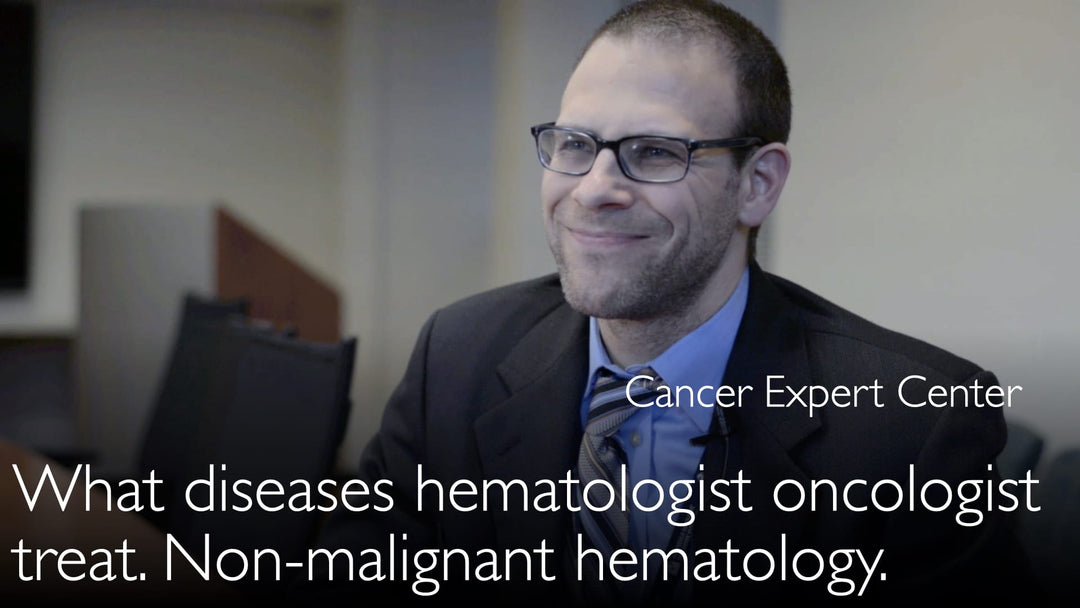Leading expert in hematology and blood disorders, Dr. Aric Parnes, MD, explains the scope of non-malignant hematology. He details common conditions like anemia, clotting disorders, and platelet abnormalities. Dr. Aric Parnes, MD, discusses the importance of accurate diagnosis and treatment for blood diseases. He highlights the global prevalence of anemia and its various causes.
Understanding Non-Malignant Hematology: Diagnosis and Treatment of Blood Disorders
Jump To Section
- What is Non-Malignant Hematology?
- Common Blood Disorders Treated
- Anemia Causes and Prevalence
- Diagnosing Blood Disorders
- Advances in Hematology Treatment
- Full Transcript
What is Non-Malignant Hematology?
Non-malignant hematology focuses on blood disorders that are not cancerous. Dr. Aric Parnes, MD, describes this medical specialty as dealing with problems related to bleeding and clotting. Hematologists also manage abnormalities in blood cell counts. This includes conditions where white blood cells, red blood cells, or platelets are too high or too low.
Common Blood Disorders Treated
Hematologists treat a wide array of common blood diseases. Dr. Aric Parnes, MD, notes that these include anemia, hemophilia, and various clotting disorders. Platelet disorders, known as thrombocytopenias or thrombocytoses, are also a core part of hematology practice. The field encompasses both the diagnosis and the comprehensive treatment of these conditions.
Anemia Causes and Prevalence
Anemia is the most frequent hematology blood disorder encountered globally. Dr. Aric Parnes, MD, emphasizes that anemia is extremely prevalent and can affect anyone. The causes of anemia are diverse and often point to underlying health issues. Nutritional deficiencies are a major cause, including a lack of iron, Vitamin B12, or folic acid.
Other significant causes of anemia include kidney dysfunction and various bone marrow diseases. Dr. Aric Parnes, MD, explains that identifying the root cause is the first critical step in effective anemia therapy.
Diagnosing Blood Disorders
Accurate diagnosis is paramount in hematology. Dr. Anton Titov, MD, discusses the role of a medical second opinion in confirming a blood disorder diagnosis. This process helps ensure the diagnosis is both correct and complete before treatment begins. A thorough evaluation often involves analyzing complete blood counts and other specialized tests to pinpoint the exact abnormality.
Advances in Hematology Treatment
Significant advances have been achieved in the treatment of blood disorders. Dr. Aric Parnes, MD, highlights that modern hematology offers a range of effective therapies for conditions like anemia and clotting problems. Choosing the best treatment is a collaborative process between the patient and their hematologist. Dr. Anton Titov, MD, reinforces that a medical second opinion can be invaluable for selecting the optimal treatment plan for any hematology blood disorder.
Full Transcript
Dr. Anton Titov, MD: Let's start with definitions. What medical problems are treated by specialists in non-malignant hematology?
Dr. Aric Parnes, MD: Hematology deals with problems with bleeding and problems with clotting. We deal with problems of abnormal blood count. White blood cell count, red blood cell count could be high or low. Platelets could be high or low.
Dr. Anton Titov, MD: What are examples of diseases a hematologist treats?
Dr. Aric Parnes, MD: The most common benign hematological disorder is anemia. Anemia is extremely prevalent. It happens worldwide. Anemia can affect anybody. We see anemia every day.
Anemia has many different causes. Causes of anemia are nutritional deficiencies. For example, iron deficiency, Vitamin B12 deficiency, folic acid deficiency. Kidney dysfunction and bone marrow diseases also cause anemia.




